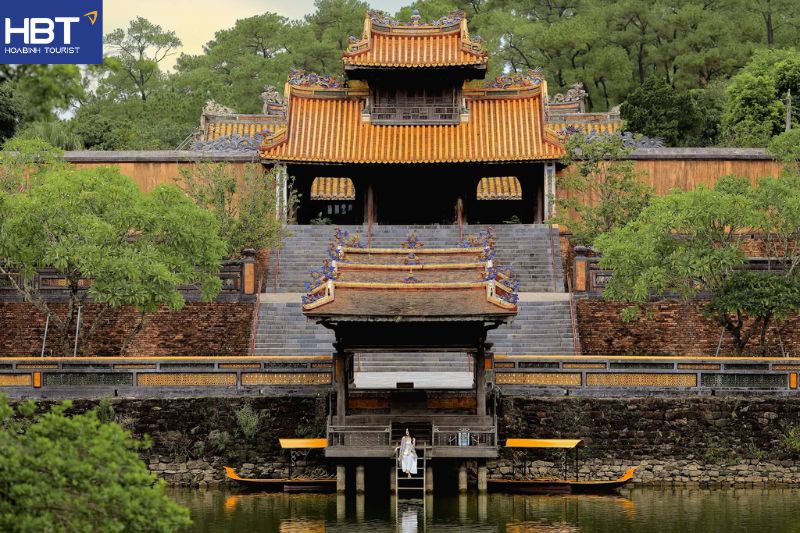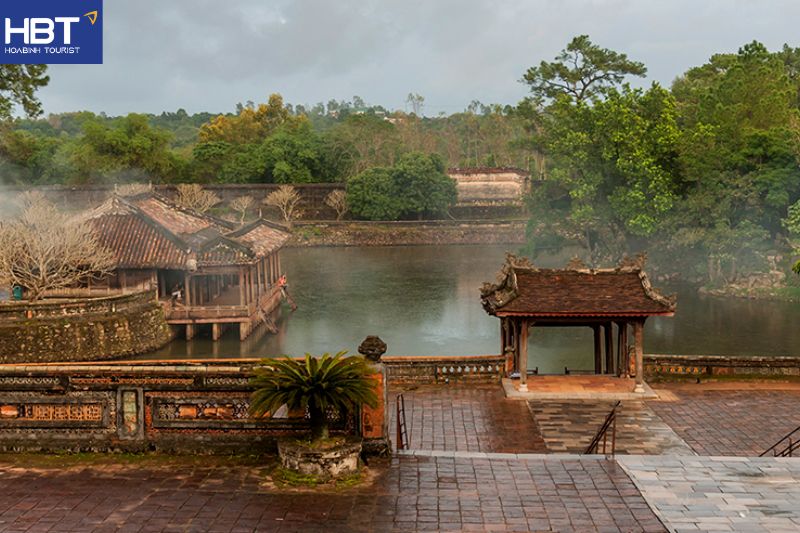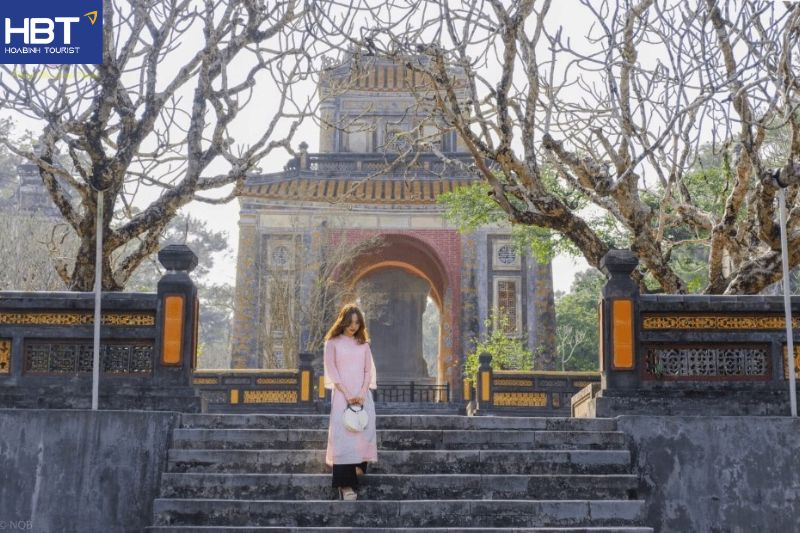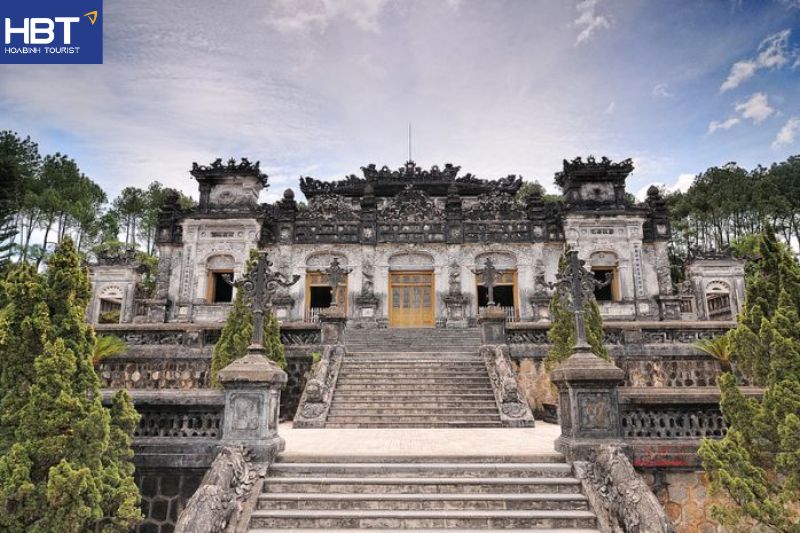Tu Duc Tomb Hue is one of the most beautiful and historically rich royal mausoleums in Vietnam. Built in the 19th century for Emperor Tu Duc, this elegant complex blends traditional architecture with tranquil natural landscapes. Just a short distance from central Hue, it offers visitors a unique glimpse into the artistic and cultural legacy of the Nguyen Dynasty.
Introduction to the Tu Duc Tomb in Hue
Tucked away in a peaceful valley just outside the center of Hue, Tu Duc Tomb is one of the most impressive and culturally rich mausoleums of the Nguyen Dynasty. Discover one of the most fascinating things to do in Hue right now!
Location
Located just 6 kilometers from the heart of Hue, Tu Duc Tomb sits in Thuy Xuan Ward, surrounded by pine forests and gentle hills. It’s set at the foot of Canh Vong Hill, beside lotus-filled lakes and serene gardens, creating a peaceful atmosphere that once served as a personal sanctuary for the emperor. The site is easily accessible by various modes of transportation, making it a convenient and rewarding stop for anyone exploring Hue’s imperial past.

Introduction to the Tu Duc Tomb in Hue
Opening hours and ticket prices
Tu Duc Tomb is open daily for visitors, typically from 6:30 AM to 5:00 PM in summer and slightly later in winter, depending on the season.
Admission fees are affordable and vary for local and international tourists. As of recent updates, the ticket price for Vietnamese adults is 100,000 VND, and for children, 20,000 VND. For international visitors, it ranges from 150,000 VND, with reduced prices for children aged 7 to 12. Children under 6 usually enjoy free entry. It’s recommended to visit in the early morning or late afternoon for the best lighting and fewer crowds.
Discover more:
Historical background and architectural features
Commissioned in 1864 and completed in 1867, Tu Duc Tomb was not only built as a mausoleum but also as a serene retreat for Emperor Tu Duc during his lifetime. Originally named Van Nien Co, it was later renamed Khiem Cung and finally Khiem Lang after the emperor’s death.
Spanning over 12 hectares, the complex includes nearly 50 structures, all marked with the word “Khiem” (meaning “modesty”) in their names. Key highlights include Khiem Cung Gate, Hoa Khiem Palace, the Minh Khiem Theater – one of Vietnam’s oldest surviving royal theaters – and the tranquil Luu Khiem Lake with its charming islets. One of the most notable features is a 20-ton stone stele engraved with over 4,900 Chinese characters written by the emperor himself – an introspective eulogy expressing his regrets and reflections.
Architecturally, the tomb is a harmonious blend of traditional Vietnamese design, Confucian aesthetics, and the natural landscape. Lush trees, lotus ponds, and winding pathways create a contemplative ambiance that mirrors the emperor’s poetic soul.

Historical background and architectural features
Cultural significance and values of Tu Duc Tomb
Tu Duc Tomb holds deep cultural and historical significance as the resting place of Vietnam’s longest-reigning Nguyen emperor (1847–1883). Known for his literary talent, refined taste, and melancholy temperament, Emperor Tu Duc left behind a tomb that is as much a reflection of his inner world as it is a symbol of royal grandeur.
Recognized as part of the UNESCO World Heritage-listed Complex of Hue Monuments, the tomb is an important cultural site that attracts both domestic and international travelers. It has also been digitally preserved through Google Arts & Culture, making it one of the first Vietnamese historical sites to be showcased globally in a virtual format.
Today, Tu Duc Tomb serves not only as a historical monument but also as a venue for cultural performances and educational tours, allowing visitors to immerse themselves in the spiritual and artistic legacy of Vietnam’s imperial past.
What to see at Tu Duc Tomb?
To help you navigate this vast cultural treasure, here are the most remarkable spots to explore within the complex:
Luu Khiem Lake and Tinh Khiem Islet
One of the first and most striking features you’ll encounter is Luu Khiem Lake, a man-made body of water that serves as the heart of the tomb’s landscape design. Calm and lotus-filled, it embodies the principle of harmony between man and nature. In the center lies Tinh Khiem Islet, where Emperor Tu Duc once grew rare plants and flowers, using it as a place of contemplation and poetic inspiration. This serene setting captures the emperor’s deep connection to nature and his desire for spiritual retreat during his lifetime.

Luu Khiem Lake and Tinh Khiem Islet
Du Khiem Ta
Bordering the lake is the charming Du Khiem Ta, a small lakeside pavilion built on stilts. It once served as the emperor’s private landing platform when arriving by boat. More than just functional, Du Khiem Ta was also a meditative space where the emperor could sit, compose poetry, or simply admire the landscape in silence. Its graceful wooden structure reflects the elegance and simplicity of traditional Hue architecture.
Hoa Khiem Palace
After crossing Khiem Cung Gate, visitors enter Hoa Khiem Palace, which functioned as the emperor’s administrative office and ceremonial hall while he was alive. Today, it serves as an ancestral temple dedicated to Emperor Tu Duc and Empress Le Thien Anh, housing altars and royal memorabilia. The surrounding buildings – Phap Khiem Vu and Le Khiem Vu – were once used by mandarins and royal attendants, completing the picture of a functioning imperial residence.
Luong Khiem Temple
Behind Hoa Khiem Palace stands Luong Khiem Temple, a solemn structure originally built as a resting place for Empress Dowager Tu Du, the emperor’s mother. The temple’s architecture is modest yet dignified, reflecting filial piety —a fundamental value in Vietnamese royal tradition. Next to the temple is On Khiem House, where the emperor’s personal belongings were stored, further humanizing the royal narrative.
Minh Khiem ancient theater
Adjacent to the temple is one of the tomb’s most culturally unique features: Minh Khiem Theater – a rare surviving royal theater built during the Nguyen Dynasty. A lover of literature and the arts, Emperor Tu Duc frequently organized performances of poetry, music, and traditional opera here. The theater’s ornate interior, complete with carved wooden columns and a star-painted ceiling, evokes the grandeur and artistic sensibility of the imperial court. Even today, it sometimes hosts reenactments of royal court music (Nha Nhac), recognized by UNESCO as Intangible Cultural Heritage.
The Tu Duc Tomb
Surprisingly, the actual tomb of Emperor Tu Duc is more understated than one might expect. It lies behind a semicircular lake, in a space that includes the Bai Dinh (Courtyard of Honor), the Bi Dinh (Stele Pavilion) featuring a 20-ton stone stele inscribed with a self-written eulogy of nearly 5,000 characters, and the emperor’s burial mound, Buu Thanh. Interestingly, some historians believe the emperor’s remains may not lie here at all, as a secret burial was allegedly arranged to prevent grave robbing. Nevertheless, this area remains one of the most contemplative parts of the entire site.

The Tu Duc Tomb
Tomb of Queen Le Thien Anh
Close to the emperor’s tomb is the final resting place of Queen Le Thien Anh, Tu Duc’s primary consort. While simpler in design, her tomb forms a deeply symbolic counterpart to the emperor’s. Their proximity reflects the enduring emotional and ceremonial bond between the royal couple, adding a layer of personal intimacy to the grandeur of the tomb complex.
Temple and tomb of King Kien Phuc
Within the same grounds lies the tomb of Emperor Kien Phuc, one of Tu Duc’s adopted sons who reigned briefly from 1883 to 1884. His temple and tomb are modest in scale, tucked quietly within the complex, and offer a sobering reminder of the turbulent succession struggles that followed Tu Duc’s death. Despite his short reign, Kien Phuc is honored with the same reverence, and his presence here completes the multi-generational narrative of this sacred site.
>> Discover more about our Hue tours:
Tips for visiting Tu Duc Tomb
To make the most of your visit to Tu Duc Tomb, it’s helpful to plan – both in terms of timing and practical details.
Best time to visit
The ideal time to visit Tu Duc Tomb is during the dry season, which lasts from March to August. During these months, Hue experiences more sunshine, less rainfall, and clearer skies, perfect for photographing the peaceful landscapes and ornate architecture.
However, if you prefer cooler weather and fewer tourists, early spring (February-March) and late autumn (October-November) are also good options, as the temperatures are milder and the site is often less crowded.
To avoid midday heat, especially in summer, it’s best to visit in the early morning (around 7:00 – 9:00 AM) or late afternoon (after 3:30 PM) when the lighting is soft and the atmosphere more tranquil.

Best time to visit Tu Duc Tomb in Hue
How to get there and transportation options
Tu Duc Tomb is located about 6 kilometers from the center of Hue city, making it easily accessible by various means of transport:
- By taxi or ride-hailing apps (Grab): This is the most convenient option, especially for groups or families. A one-way ride from the city center typically costs 50,000 – 80,000 VND.
- By motorbike or bicycle: Adventurous travelers can rent a motorbike (100,000 – 150,000 VND/day) or bicycle (30,000 – 50,000 VND/day) to explore Hue’s tomb circuit at their own pace. The route to Tu Duc Tomb is scenic, taking you through local villages and tree-lined roads.
- By cyclo (xích lô): For a more leisurely ride and a touch of old-world charm, consider hiring a cyclo driver for a few hours. Be sure to agree on a price beforehand.
- Tour packages: Many guided tours of Hue’s royal tombs include Tu Duc Tomb as part of a half-day or full-day itinerary, often paired with Khai Dinh and Minh Mang Tombs.
Dress code when visiting the site
Although Tu Duc Tomb is no longer an active place of worship, it remains a deeply respected cultural and historical site. Visitors are expected to dress modestly and appropriately:
- Avoid wearing short skirts, shorts above the knee, sleeveless tops, or overly revealing clothing.
- Light, breathable fabrics are recommended, especially during hot months.
- Comfortable walking shoes or sandals are essential, as the complex is large and involves uneven stone paths and stairs.
- Bringing a hat, sunglasses, and sunscreen is highly advised, especially for midday visits.
- Respectful behavior is also important: refrain from loud conversations, climbing on structures, or touching altars and relics.
Nearby attractions
If you have time, combine your visit to Tu Duc Tomb with other nearby cultural sites to enrich your Hue experience:
- Khai Dinh Tomb (about 10 km away): A dramatic, European-influenced royal tomb built into a hillside, known for its elaborate mosaics and imperial grandeur.
- Minh Mang Tomb (about 12 km away): Set amidst lakes and gardens, this tomb reflects Confucian ideals and offers a peaceful retreat from the city.
- Tu Hieu Pagoda (less than 2 km away): One of Hue’s most tranquil and historically important Buddhist temples, where many Nguyen Dynasty eunuchs are buried.
- Vong Canh Hill: A scenic viewpoint not far from the tomb, offering sweeping views of the Perfume River and countryside, perfect for sunrise or sunset.
- Thuy Xuan Incense Village: A colorful village where traditional incense sticks are made by hand. It’s on the way to the tomb and great for a short photo stop.

Khai Dinh Tomb – One of the best attractions in Hue
Visiting Tu Duc Tomb is more than just a journey into Vietnam’s imperial history; it’s an immersion into poetic landscapes, refined architecture, and the spiritual legacy of a bygone era. If you’re looking for a seamless and enriching way to explore this cultural capital, HoaBinh Tourist is here to help.
Our carefully crafted Hue tours combine historical insights with local experiences, offering you comfort, expert guidance, and unforgettable moments every step of the way. Ready to discover Hue in style and depth? Contact HoaBinh Tourist today to book your customized itinerary or join one of our cultural heritage tours, and let us bring the timeless beauty of Hue to life for you.












